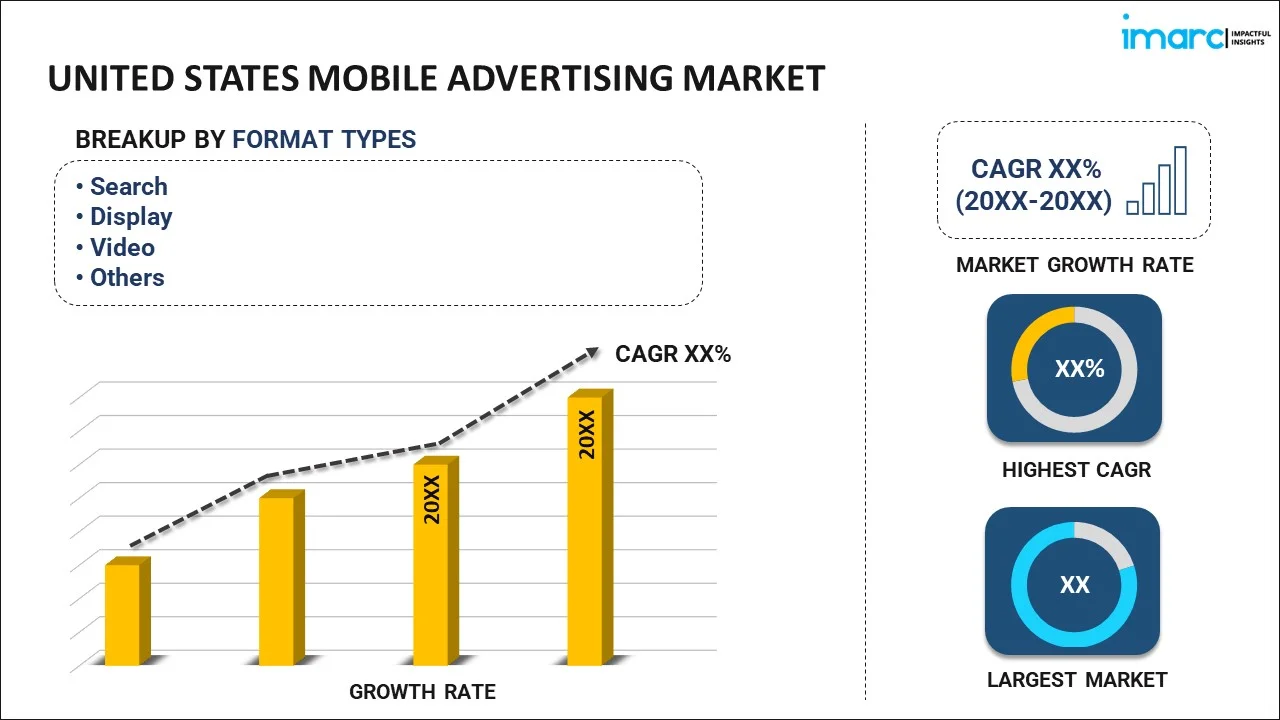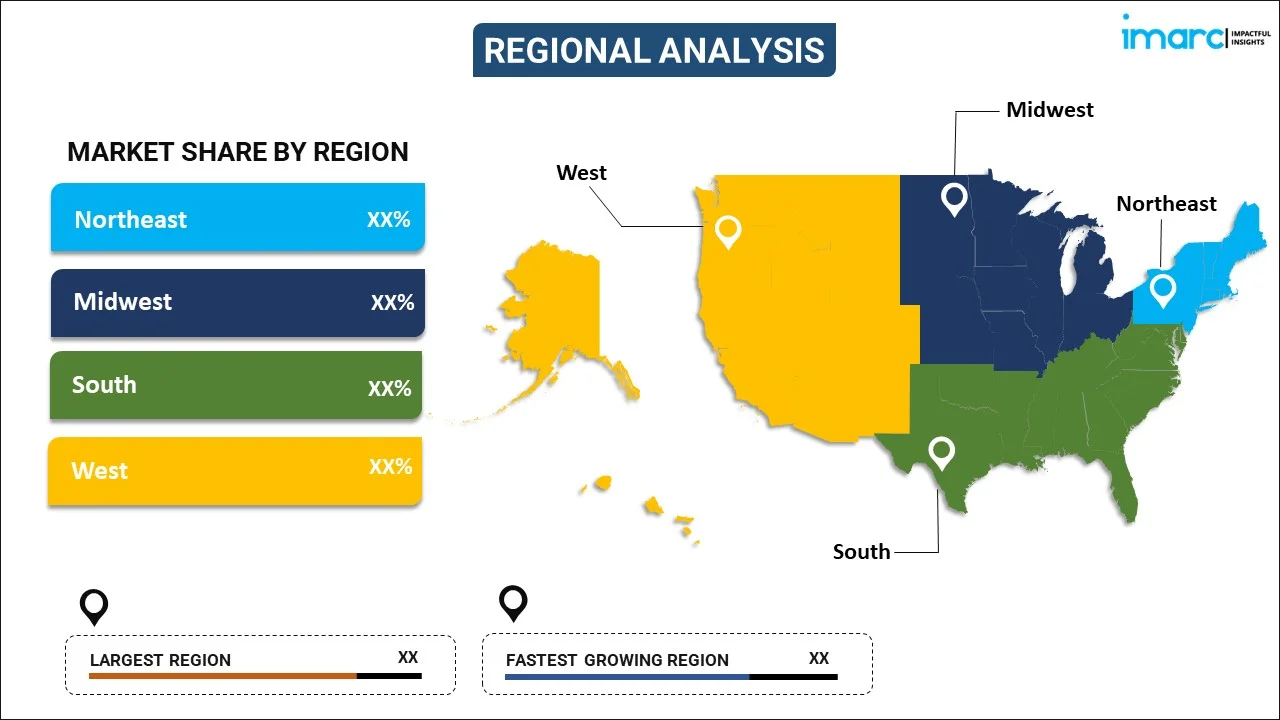
United States Mobile Advertising Market Report by Format Type (Search, Display, Video, Social Media, Websites, and Others), Industry Vertical (Retail and E-commerce, Media and Entertainment, Healthcare, BFSI, Education, Travel and Tourism, Automotive, and Others), and Region 2025-2033
Market Overview:
The United States mobile advertising market size reached USD 68.7 Billion in 2024. Looking forward, IMARC Group expects the market to reach USD 227 Billion by 2033, exhibiting a growth rate (CAGR) of 14.2% during 2025-2033. The widespread adoption of smartphones, the growing use of mobile devices to access the internet, considerable growth in the popularity of mobile apps, the advanced targeting and personalization offered by mobile advertising, and rapid modernization of ad formats are some of the factors propelling the market.
|
Report Attribute
|
Key Statistics
|
|---|---|
|
Base Year
|
2024 |
|
Forecast Years
|
2025-2033
|
|
Historical Years
|
2019-2024
|
| Market Size in 2024 | USD 68.7 Billion |
| Market Forecast in 2033 | USD 227 Billion |
| Market Growth Rate (2025-2033) | 14.2% |
Mobile advertising refers to the practice of delivering promotional messages and advertisements to users on their mobile devices, such as smartphones and tablets. It has become a crucial component of the digital marketing landscape as the use of mobile devices continues to grow. It encompasses various formats, including display ads, video ads, native ads, and interactive rich media ads strategically placed within mobile apps, websites, social media platforms, and other mobile content. Its distinctive nature lies in its ability to leverage the unique features of mobile devices, including location data, touchscreens, and device-specific functionalities. Advertisers use mobile platforms to engage with their target audience, deliver personalized content, and drive specific actions such as app installations, website visits, or product purchases. Its key advantages include its reach, as individuals carry their mobile devices with them throughout the day, and its potential for precise targeting based on factors like location, demographics, and user behavior. Mobile advertising also benefits from the immediacy of user interaction, allowing for real-time engagement and feedback. As technology advances, it continues to evolve with innovations such as augmented reality (AR) and virtual reality (VR) ads, further enhancing user experiences.
United States Mobile Advertising Market Trends:
The market in the United States is majorly driven by the widespread and increasing adoption of smartphones. With a large percentage of the population owning and actively using smartphones, advertisers see a vast and diverse audience to target through mobile platforms. Furthermore, the rising mobile internet usage is significantly contributing to the market growth. This shift in consumer behavior creates ample opportunities for advertisers to connect with audiences through various channels, including mobile apps, websites, and social media platforms. Besides, app monetization is a key factor catalyzing the market. The rising prevalence of mobile apps for diverse purposes, from social networking to gaming, has led to increased in-app ad spending. Moreover, advanced targeting and personalization capabilities play a crucial role in propelling the market. Advertisers leverage sophisticated data analytics to target specific demographics, locations, and user interests, enhancing the relevance of their ad campaigns. Apart from this, the emergence of new and innovative ad formats is bolstering the market. Interactive ads, video ads, and immersive experiences are reshaping the landscape of mobile advertising in the U.S. Advertisers are keen on adopting these novel formats to capture users' attention, create memorable brand interactions, and differentiate their campaigns in a competitive market. Additionally, continual advancements in the technological landscape is fostering continuous innovation in mobile advertising. As technologies like augmented reality (AR) and virtual reality (VR) gain traction, advertisers are exploring new ways to leverage these immersive experiences in their mobile campaigns. This, in turn, is providing a boost to the market.
United States Mobile Advertising Market Segmentation:
IMARC Group provides an analysis of the key trends in each segment of the market, along with forecasts at the country level for 2025-2033. Our report has categorized the market based on format type and industry vertical.
Format Type Insights:

- Search
- Display
- Video
- Social Media
- Websites
- Others
The report has provided a detailed breakup and analysis of the market based on the format type. This includes search, display, video, social media, websites, and others.
Industry Vertical Insights:
- Retail and E-commerce
- Media and Entertainment
- Healthcare
- BFSI
- Education
- Travel and Tourism
- Automotive
- Others
A detailed breakup and analysis of the market based on the industry vertical have also been provided in the report. This includes retail and e-commerce, media and entertainment, healthcare, BFSI, education, travel and tourism, automotive, and others.
Regional Insights:

- Northeast
- Midwest
- South
- West
The report has also provided a comprehensive analysis of all the major regional markets, which include Northeast, Midwest, South, and West.
Competitive Landscape:
The market research report has also provided a comprehensive analysis of the competitive landscape in the market. Competitive analysis such as market structure, key player positioning, top winning strategies, competitive dashboard, and company evaluation quadrant has been covered in the report. Also, detailed profiles of all major companies have been provided.
United States Mobile Advertising Market Report Coverage:
| Report Features | Details |
|---|---|
| Base Year of the Analysis | 2024 |
| Historical Period | 2019-2024 |
| Forecast Period | 2025-2033 |
| Units | Billion USD |
| Scope of the Report | Exploration of Historical Trends and Market Outlook, Industry Catalysts and Challenges, Segment-Wise Historical and Future Market Assessment:
|
| Format Types Covered | Search, Display, Video, Social Media, Websites, Others |
| Industry Verticals Covered | Retail and E-commerce, Media and Entertainment, Healthcare, BFSI, Education, Travel and Tourism, Automotive, Others |
| Regions Covered | Northeast, Midwest, South, West |
| Customization Scope | 10% Free Customization |
| Post-Sale Analyst Support | 10-12 Weeks |
| Delivery Format | PDF and Excel through Email (We can also provide the editable version of the report in PPT/Word format on special request) |
Key Questions Answered in This Report:
- How has the United States mobile advertising market performed so far and how will it perform in the coming years?
- What has been the impact of COVID-19 on the United States mobile advertising market?
- What is the breakup of the United States mobile advertising market on the basis of format type?
- What is the breakup of the United States mobile advertising market on the basis of industry vertical?
- What are the various stages in the value chain of the United States mobile advertising market?
- What are the key driving factors and challenges in the United States mobile advertising?
- What is the structure of the United States mobile advertising market and who are the key players?
- What is the degree of competition in the United States mobile advertising market?
Key Benefits for Stakeholders:
- IMARC’s industry report offers a comprehensive quantitative analysis of various market segments, historical and current market trends, market forecasts, and dynamics of the United States mobile advertising market from 2019-2033.
- The research report provides the latest information on the market drivers, challenges, and opportunities in the United States mobile advertising market.
- Porter's five forces analysis assist stakeholders in assessing the impact of new entrants, competitive rivalry, supplier power, buyer power, and the threat of substitution. It helps stakeholders to analyze the level of competition within the United States mobile advertising industry and its attractiveness.
- Competitive landscape allows stakeholders to understand their competitive environment and provides an insight into the current positions of key players in the market.
Need more help?
- Speak to our experienced analysts for insights on the current market scenarios.
- Include additional segments and countries to customize the report as per your requirement.
- Gain an unparalleled competitive advantage in your domain by understanding how to utilize the report and positively impacting your operations and revenue.
- For further assistance, please connect with our analysts.
 Request Customization
Request Customization
 Speak to an Analyst
Speak to an Analyst
 Request Brochure
Request Brochure
 Inquire Before Buying
Inquire Before Buying




.webp)




.webp)












